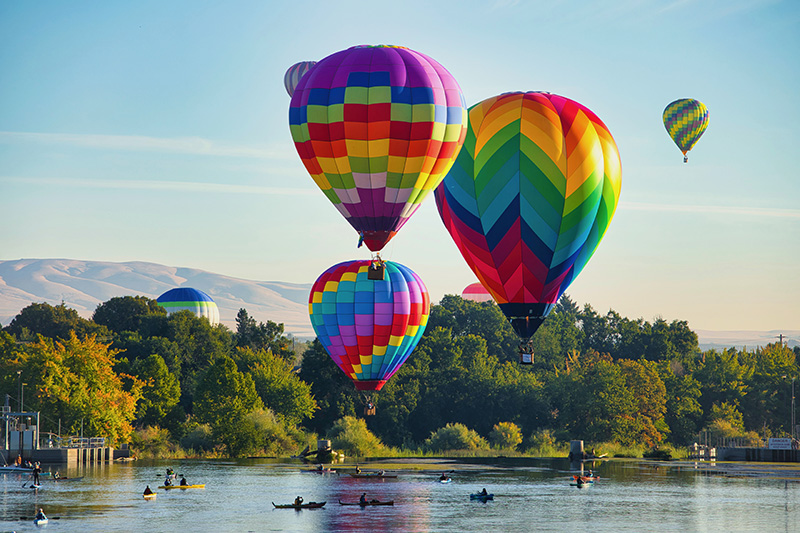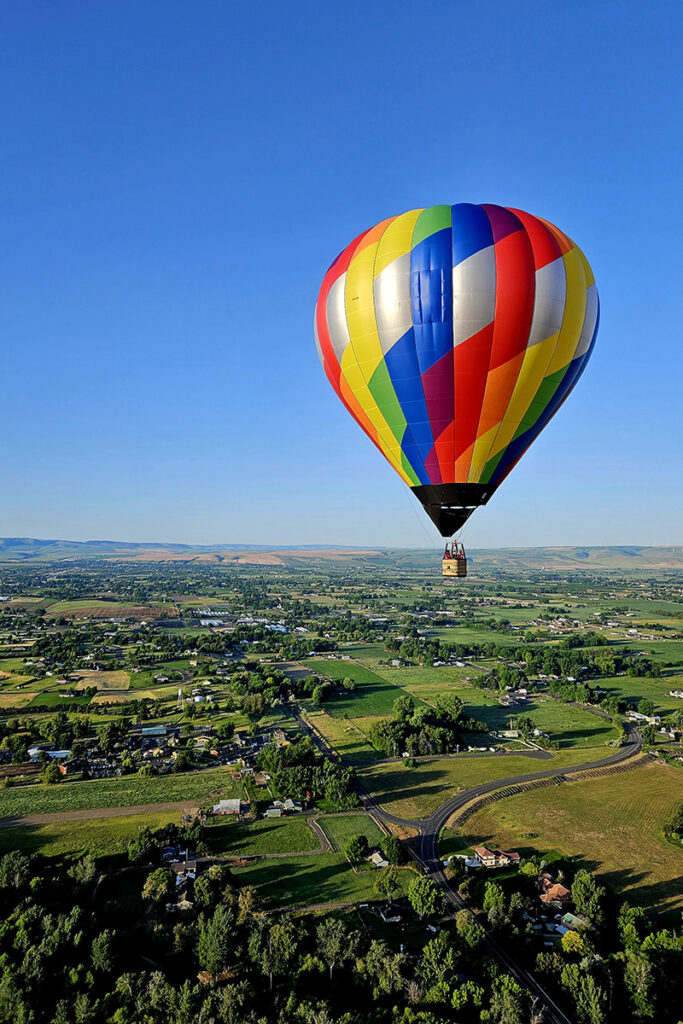Cover photo courtesy of Lynn Hopwood
By Tabitha Gregory
Big and brilliant, hot air balloons have long captivated the public’s imagination. The sight of a gentle giant floating above the landscape stops traffic and brings children and parents out of their homes to watch. The longing to be in a balloon, untethered from the earth, serenely observing the model world below, brings tens of thousands of would-be flyers to climb into wicker baskets in the wee hours of a morning each year. I am one such person.
A balloon flight had been on my radar for a couple of years when I booked a flight with Okanagan Ballooning, a family-owned operation based in the lakeside city of Kelowna. The confirmation email from owner John Klempner told me to bring a warm layer and be prepared for a three-hour outing. I headed north, ready for an adventure.
While ballooning occurs in the Inland Northwest and greater Pacific Northwest from May through October (and in a few instances year-round), autumn is an especially nice time to fly. Throughout the Inland Northwest, at least three companies operate out of locations near Walla Walla, the Tri-Cities, and Boise. According to Andrew Petrehn of Idaho Balloon Adventures, “Peak season for color is late September and early October. We take off just before the sun comes up and watch as it rises over the mountains and warms up the colors along the Boise River.” Walla Walla Balloon Flights pilot Devin White shares, “Fall is the perfect season for ballooning in the Inland Northwest, as we’re treated with stable weather, cooler temperatures, and stunning scenery.”
When my flight day arrived this past May, the weather was perfect at 60 F with calm winds. Klempner called my cell at 5 a.m., reminding me to be on time for a 6 a.m. ride to the launch site. As instructed, I found John, his wife Joy, the flight crew, and six other passengers. We headed for the hills.

Photo courtesy of Lynn Hopwood
We pulled into an overgrown field, thick with blooming mustard and mosquitoes. The crew, mostly Klempner family members, hauled from the trailers twin baskets, canvas bags containing the envelopes (deflated balloons), generators, fans, and propane burners. Then, with the help of passengers, they strung out the two ripstop nylon envelopes atop the spiky weeds, tipped the baskets onto their sides, and used suspension cables to connect the baskets and envelopes.
Generator-powered fans sent ambient air into the envelopes, coaxing open the fabric, then the crew swapped in the real power: huge propane burners blowing waves of hot gas. Gradually, the balloons began to rise, first one side, then the whole structure, handlers gripping the tethers and leaning back, anchoring the eager giants to the earth.
Klempner invited five of us into his standing room only basket. We situated ourselves around the edges, arms resting on the ledges, our gazes outward. The sun rose, and a few filmy clouds crossed the sky. Joy and the ground crew cheered as they released the tethers, and our balloon lifted off.

Photo courtesy of Dianne LaBissoniere
Ballooning for most of us is a once-in-a-lifetime adventure. Some become repeat customers. A few evolve into pilots. The solo path requires experience, often on a crew such as Klempner’s, passing a Federal Aviation Administration test, and buying gear. An entry-level kit costs around $25,000.
I peered over the woven basket’s edge as we floated upward. Using the onboard burner, Klempner blasted gas into the balloon’s gut, moving us into a higher current. We drifted toward 84-mile-long Okanagan Lake, then toward the Columbia Mountains. We meandered north, then west, then hung gracefully over orchards, the backdrop featuring the snowcapped Big White Mountain. Our basket lazily rotated, providing us each a 360-degree view.
I learned there is no steering a balloon. Instead, pilots control altitude by releasing or adding gas, thereby reaching an air layer moving in the desired direction. Klempner deftly managed the calm but ever-changing wind patterns.

Photo courtesy of Lauren White
After 45 minutes of poking about the troposphere, Klempner began seeking a landing zone. “Parks, churchyards, sports fields, and meadows all make great landing spots,” he said.
The lower we sank, the more of a spectacle we became. Drivers pulled over and walkers paused to watch. As we coasted onto a grassy park lawn, children stopped their play to stare wide-eyed as this fantastical craft touched down.
Tabitha Gregory enjoys exploring, hiking, and skiing in the Inland Northwest. She writes for Out There Outdoors and North Columbia Monthly and is the author of the historical non-fiction book “Valdez Rises: One Town’s Struggle for Survival After the Great Alaska Earthquake.”
The post Hot Air Balloon Rides in the Inland Northwest appeared first on Out There Outdoors.
By Tabitha Gregory
Big and brilliant, hot air balloons have long captivated the public’s imagination. The sight of a gentle giant floating above the landscape stops traffic and brings children and parents out of their homes to watch. The longing to be in a balloon, untethered from the earth, serenely observing the model world below, brings tens of thousands of would-be flyers to climb into wicker baskets in the wee hours of a morning each year. I am one such person.
A balloon flight had been on my radar for a couple of years when I booked a flight with Okanagan Ballooning, a family-owned operation based in the lakeside city of Kelowna. The confirmation email from owner John Klempner told me to bring a warm layer and be prepared for a three-hour outing. I headed north, ready for an adventure.
While ballooning occurs in the Inland Northwest and greater Pacific Northwest from May through October (and in a few instances year-round), autumn is an especially nice time to fly. Throughout the Inland Northwest, at least three companies operate out of locations near Walla Walla, the Tri-Cities, and Boise. According to Andrew Petrehn of Idaho Balloon Adventures, “Peak season for color is late September and early October. We take off just before the sun comes up and watch as it rises over the mountains and warms up the colors along the Boise River.” Walla Walla Balloon Flights pilot Devin White shares, “Fall is the perfect season for ballooning in the Inland Northwest, as we’re treated with stable weather, cooler temperatures, and stunning scenery.”
When my flight day arrived this past May, the weather was perfect at 60 F with calm winds. Klempner called my cell at 5 a.m., reminding me to be on time for a 6 a.m. ride to the launch site. As instructed, I found John, his wife Joy, the flight crew, and six other passengers. We headed for the hills.

Photo courtesy of Lynn Hopwood
We pulled into an overgrown field, thick with blooming mustard and mosquitoes. The crew, mostly Klempner family members, hauled from the trailers twin baskets, canvas bags containing the envelopes (deflated balloons), generators, fans, and propane burners. Then, with the help of passengers, they strung out the two ripstop nylon envelopes atop the spiky weeds, tipped the baskets onto their sides, and used suspension cables to connect the baskets and envelopes.
Generator-powered fans sent ambient air into the envelopes, coaxing open the fabric, then the crew swapped in the real power: huge propane burners blowing waves of hot gas. Gradually, the balloons began to rise, first one side, then the whole structure, handlers gripping the tethers and leaning back, anchoring the eager giants to the earth.
Klempner invited five of us into his standing room only basket. We situated ourselves around the edges, arms resting on the ledges, our gazes outward. The sun rose, and a few filmy clouds crossed the sky. Joy and the ground crew cheered as they released the tethers, and our balloon lifted off.

Photo courtesy of Dianne LaBissoniere
Ballooning for most of us is a once-in-a-lifetime adventure. Some become repeat customers. A few evolve into pilots. The solo path requires experience, often on a crew such as Klempner’s, passing a Federal Aviation Administration test, and buying gear. An entry-level kit costs around $25,000.
I peered over the woven basket’s edge as we floated upward. Using the onboard burner, Klempner blasted gas into the balloon’s gut, moving us into a higher current. We drifted toward 84-mile-long Okanagan Lake, then toward the Columbia Mountains. We meandered north, then west, then hung gracefully over orchards, the backdrop featuring the snowcapped Big White Mountain. Our basket lazily rotated, providing us each a 360-degree view.
I learned there is no steering a balloon. Instead, pilots control altitude by releasing or adding gas, thereby reaching an air layer moving in the desired direction. Klempner deftly managed the calm but ever-changing wind patterns.

Photo courtesy of Lauren White
After 45 minutes of poking about the troposphere, Klempner began seeking a landing zone. “Parks, churchyards, sports fields, and meadows all make great landing spots,” he said.
The lower we sank, the more of a spectacle we became. Drivers pulled over and walkers paused to watch. As we coasted onto a grassy park lawn, children stopped their play to stare wide-eyed as this fantastical craft touched down.
Tabitha Gregory enjoys exploring, hiking, and skiing in the Inland Northwest. She writes for Out There Outdoors and North Columbia Monthly and is the author of the historical non-fiction book “Valdez Rises: One Town’s Struggle for Survival After the Great Alaska Earthquake.”
The post Hot Air Balloon Rides in the Inland Northwest appeared first on Out There Outdoors.
